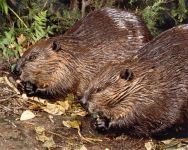


|

|
|
 
|
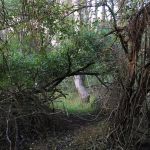
31st: In order to provide the least disturbance to habitat, clearing of our trails is kept to the minimum necessary for human passage. As you can see here, we sometimes have to be 'creative' in order to accomplish our goal. – VVH

29th: Although we share and celebrate our wildlife successes with our supporters, it is important to point out the failures so that we may learn how to handle future issues. Last year, on Christmas Eve, we were unsuccessful in trying to save a family of beavers on a small lake in Toms River, NJ. The Refuge and many other groups and volunteers offered to pay for, install and maintain flow devices on the lake in an attempt to allay residents' perceived concerns, but the mayor refused all offers of help. The beavers had not built a dam on the lake and had caused none of the problems feared by the home owners. The two, small lodges they built were innocuous, yet were destroyed by the township. Despite public protests, including by many neighbors and home owners, and a petition with thousands of signatures pleading with Toms River to save the family, the mayor ordered all the beavers to be killed. We believe we have at least educated people, which may be useful if other beavers move into the lake. #tbt #throwbackthursday #uwrhistory #tomsriver #tomsriverbeavers #lakeplacid – VVH
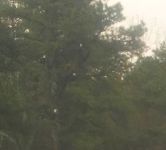
28th: There are an estimated 150 mated bald eagle pairs in New Jersey. We were understandably excited when two eagles we had seen frequently last winter appeared with a juvenile this spring. The three have been an almost daily sight at the main pond, flying, roosting and fishing together. Unfortunately, they were nowhere to be seen each time our local photographers showed up. Yesterday afternoon, I heard them calling loudly. One of the adults landed high in a tree across the main pond, a tree that already had three other adult bald eagles.
As luck would have it, all I had with me was a cell phone, so the quality of this photo is poor. We are unlikely, however, to get another chance to photograph a 'cluster' of eagles, so I am sharing this regardless. – VVH
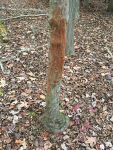
26th: The bucks at the Refuge have been leaving messages on the trees all fall. Known colloquially as "deer rubs", these not only are part of the process of removing 'velvet' from the antlers, they also provide visible and scent clues to other local deer during the rutting season. – VVH
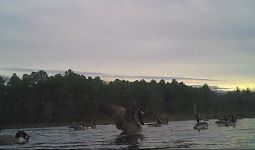
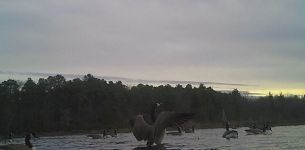
24th: This time of year, the main pond becomes a popular rest stop for migrating Canada geese. Here, a goose slowly flaps his wings in greeting to his fellow travelers. The gesture was picked up by each of the other geese and the wing-flapping simultaneously moved through the whole group. – VVH
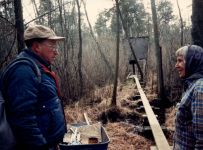
22nd: Refuge co-founder Hope Sawyer Buyukmihci and long-time Refuge friend and volunteer, Augie Sexauer, move supplies to Otter Dam in this photo from 1988. #ThrowbackThursday #TBT #UWRHistory – VVH
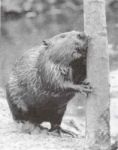

19th, UPDATE: There has been a stay of execution for the beavers, I am very grateful to say. I spoke to Michael Fitzpatrick at Mansfield Township and he told me the Township have agreed to halt the trapping! Fitzpatrick will send me a message to this effect so that I can forward options for them to discuss. They seem very committed to live-trapping and relocating in the spring. Although this is better than killing the beavers, I am going to do my best to get the people to adopt an attitude of tolerance so that the beavers can remain as undisturbed as feasible. #MansfieldBeavers
19th: WE NEED YOUR HELP. A family of beavers in Mansfield Township, New Jersey, is going to be killed THIS WEEK unless we can convince the Township that this is inhumane and unnecessary. CALL MAYOR SEAN GABLE at 609-298-0542, and politely ask him to let us come in and help instead of killing these beavers. We have volunteers and funds to protect trees (the township's concern). – VVH
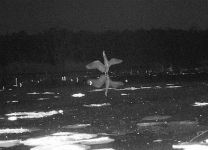
17th: With our new gift of a set of neoprene chest waders by a generous donor, I am now able to get our trail cameras into spots that were previously difficult to access. I placed one almost in the middle of the main pond and the same night the infrared trigger captured this beautiful, otherworldly image of a great blue heron landing on the water. – VVH
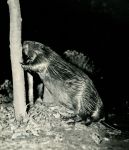
15th: In this 1966 photo by Refuge co-founder Hope Sawyer Buyukmihci, a beaver is gnawing into a small poplar tree for food or building materials. A common myth is that beavers will "destroy all the trees" in an area. This short-sighted excuse to continue trapping and killing the beavers is not borne out by available evidence. Although some trees are removed, there is always a balance and beavers will move to other territories in search of new resources without ever denuding a current one. #ThrowbackThursday #TBT #UWRHistory – VVH
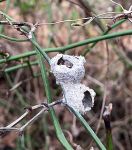
14th: Wasps of the mud-dauber families build a variety of gorgeous nests, including the stunning "organ-pipe" nests. Here is another style of nest built at the Refuge by, we believe, potter wasps, one of these docile wasp species. – VVH
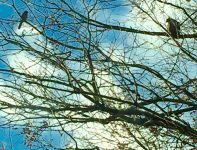
12th: This cedar waxwing and red-tailed hawk sit, perhaps companionably, in a tree near one of the trails at the Refuge. – VVH


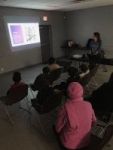
10th: I was thrilled to be invited last week to speak about wildlife to a group of elementary-school children at an afterschool program in Newfield, NJ. I brought many photos and stories, but the kids 'ran' the show. These children had many interesting, smart and funny questions which kept me talking for forty minutes longer than I was scheduled. Some of my favorite topics of the evening were:
These and other questions reinforced the fact that kids are naturally curious about the world around them. It also reminded me just how important it is that we – the Refuge and others – ensure that children are provided with a non-homocentric view of the world, instilling in them respect and tolerance for other life with whom we only share, not own, this planet. – VVH
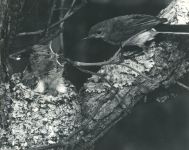
8th: We have many wonderful old photos taken at the Refuge. Unfortunately, many have no information concerning who took them or even when they were taken. Nevertheless, we want to share these with you. One such photo is of this mother blue-gray gnatcatcher feeding her young. Gnatcatchers spend their summers at the Refuge. #tbt #throwbackthursday #uwrhistory – VVH
Editor's note: Since our original post of this item, we have learned that this photo was taken by Ray Davis, a frequent visitor to the Refuge. – NCB
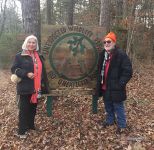

7th: New Jersey's six-day firearm killing 'season' is always our busiest and our most important week of patrol. Here are some of the smiling faces of our awesome volunteers who helped us in this endeavor: Judy Horowitz and Howard Rosenblatt standing next to our sign and Mary Ann Gurka along one of our trails. – VVH
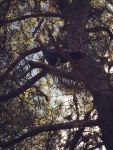
5th: This wild turkey took sanctuary in a tall tree at the Refuge. This species was driven almost to extinction in the United States in the 1930s due to rapid habitat loss and hunting. Fortunately, some of the habitat of the turkeys was restored or left intact, allowing the birds to flourish. Although this is considered a 'success' story, the turkeys continue to face death by hunting. – VVH
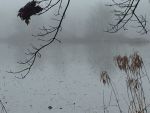
3rd: We've had a series of unseasonably warm days recently, warming the waters of the main pond and creating incredible morning fog that lasts well into the morning. This shot was taken at 10:30 am, hours after our mists usually burn off with the morning sun. – VVH
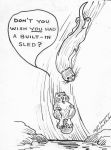
1st: In addition to her paintings and wildlife sketches having a serious theme, Refuge co-founder Hope Sawyer Buyukmihci also produced many light-hearted drawings. This one featuring a beaver and an otter is one of our favorites. #ThrowbackThursday #TBT #UWRHistory – VVH
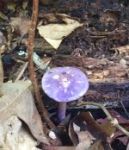
30th: We found this beautifully vibrant viscid violet cort mushroom on one of the trails. These fungi are a colorful part of the numerous species of wild mushrooms at the Refuge. – VVH
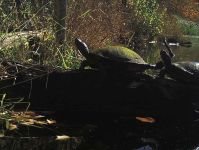
28th: The large red-bellied turtle on the left was basking contentedly on a fallen branch in the main pond. When the second one appeared, the first one spent the next ten minutes placidly exerting his dominion over the basking site until the newcomer moved out of his way! – VVH
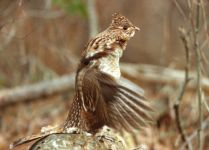
24th: Unexpected has long been a favorite "studio" for New Jersey and Philadelphia-area photographers like Ed Abbott. One March day in 1990, Ed was in the right place at the right time and was able to take a series of stunning photos of a ruffed grouse "drumming". The male makes this sound by beating his wings rapidly to let others know he is looking for a mate and that this is his territory. He will often choose a stump or rock to stand upon for this impressive annual spring display. #ThrowbackThursday #TBT #UWRHistory – VVH
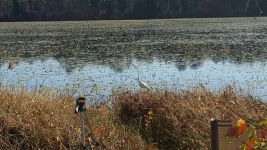
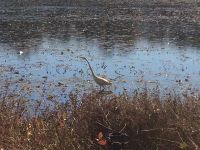
22nd: Volunteers Jason Howell and Mike Hickey managed to get these nice photos of a great egret fishing near the edge of the main pond at the Refuge. – VVH
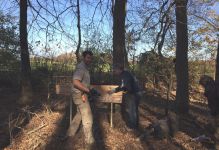
20th: Thank you to hard-working volunteers from the Pinelands Protection Alliance for helping us make and install some new Atlantic white cedar trail signs along the boundary and inner trails at the Refuge. These signs are just in time for fall patrol, they look great and should help prevent other volunteers becoming lost along our many trails! Pictured from left are Jason Howell, Mike Hickey and Paula Yudkowitz. #pinelandsprotectionalliance #PPA #NJtrails – VVH
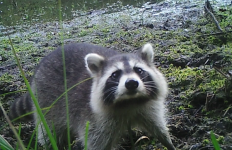
19th: As we near the close of our 55th year of protecting wildlife, we thank all the volunteers and supporters who have helped us keep Unexpected Wildlife Refuge safe. We hope you have enjoyed our wildlife photos, our successes and the events we have had at the Refuge.
Remember, we run solely on private donations. Please keep us in mind during this holiday season. We know you will be inundated with options, but even a small gift to the Refuge – $10, $25, $50 – will help us keep the Refuge the sanctuary for wildlife it has been for more than five decades.
Every donation helps!
For Wildlife Everywhere, thank you! – VVH
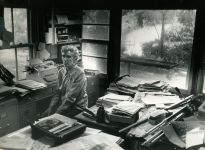
17th: For our Throwback Thursday post this week, here is a photo of Refuge co-founder Hope Sawyer Buyukmihci in her office in September 1971, posing for an article in the Philadelphia Inquirer. Hope wrote many inspiring stories about wildlife using that manual typewriter you see on her desk, typing up to 90 words a minute with rarely a mistake! It is a marvel that she could concentrate on her 'work' with the distraction provided by the main pond continually visible through her window. #uwrhistory #tbt #throwbackthursday – VVH
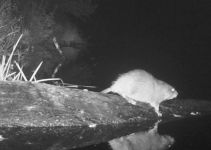
14th: For weeks during the evenings, we saw someone who appeared to be a small beaver, swimming busily in the middle of the main pond. While this individual was nosing around one of the favorite perches of the local turtles, she managed to photograph herself by one of the trail cameras. We were delighted to see that she was a resident muskrat. – VVH
|
12th: Most nights at dusk, we see one or two beavers swimming in the main pond. Recently, however, we were absolutely thrilled when we saw a family of six swimming in a circle, vocalizing profusely with each other. Unfortunately, their voices did not register in the video (unlike those of some visiting Canada geese). We watched the beavers until there was no light left in the sky. We can only surmise that this uptick in activity was due to the family busily seeking food to store in their lodge for the winter. Here is a direct link to the video in case you have difficulty playing it on this page. – VVH |
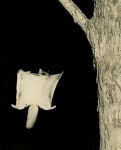
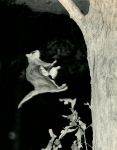
10th: For our Throwback Thursday post this week, we pay tribute to Al Francesconi, who was a long-time friend of the Refuge and a patient and gifted photographer. He contributed many wonderful photos for our archives. Here are two he took in 1966, showing a so-called flying squirrel about to land on a tree. #uwrhistory #tbt #throwbackthursday – VVH
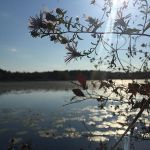
9th: Some purple slender aster over the main pond. Aster has been extirpated from many of the places where it traditionally grew. It is a conservation concern everywhere due to loss of much-needed habitat from human interference. – VVH
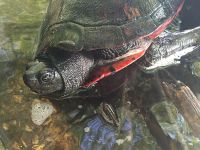
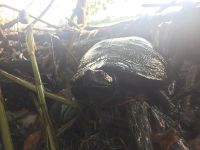
7th: This beautiful northern red-bellied turtle (Pseudemys rubriventris), also known as the American red-bellied turtle or northern red-bellied cooter, was seen basking in the fading light of an afternoon, sitting upon one of the many small beaver dams at the Refuge. Federally listed as endangered, the red-bellied turtle has faced significant threats due to habitat destruction from human degradation of wetlands leading to a loss of safe basking spots. – VVH
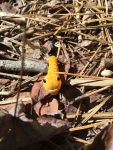
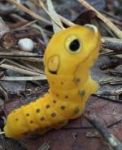
5th: We saw this colorful little spicebush swallowtail butterfly caterpillar recently in the middle of one of the trails. Spicebush swallowtails begin life green or green-brown. They are camouflaged discreetly to the color of the leaves of the plant on which the mother chose to lay her eggs. When the caterpillar emerges, he or she will stay rolled up in a leaf which provides a source of food as well as a hiding place from predators. As they mature, they will turn yellow, leave the protection of the leaf and walk along the ground searching for a low-lying leaf upon which to spin a chrysalis. This one is about to do just that. – VVH

3rd: For our Throwback Thursday post this week, here is a picture of Cavit Buyukmihci, co-founder of the Refuge, in his 'signature' hat. We do not know the date this photo was taken, but it would have been in the late 1970s or early 1980s. Cavit was a staunch protector of wildlife and used the earnings from his day job as a metallurgical engineer to start and operate the Refuge until his death in 1987. #uwrhistory #tbt #throwbackthursday – VVH
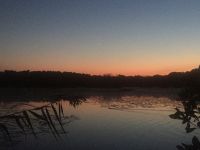
2nd: I set out one early evening to capture a photograph of Venus reflected upon the surface of the main pond. As I was taking photos, a beaver swam by leaving a crisp wake and providing me with an even better experience. – VVH

31st: It is a good day when a raccoon "discovers" one of our trail cameras. These inquisitive individuals always give us the best close-ups! This mother had two small, chubby siblings in tow. In case you are not familiar with raccoon family life, they will stay together, sleeping, foraging and exploring their environs, until the young are about a year old. After this, the youngsters have to make their own way in the world. – VVH
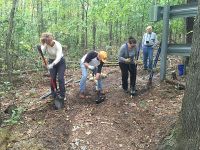
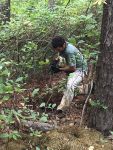
29th: Our deepest gratitude goes to everyone who donated to our GoFundMe campaign to help us raise money to install extra trail protections at the Refuge to discourage illegal off-road vehicle use near some ecologically sensitive wetland areas. We were not able to meet our goal to purchase boulders, but received invaluable help by the Pinelands Protection Alliance (PPA).
Volunteers from this group – whose mission is to protect our unique Pinelands ecosystem – spent a day building layers of bulwarks against four-wheel vehicles and dirt bikes. One photo shows, left to right, Lee Yeash, John Silverio, Erin Pierson and Albert Horner. The other is of Jason Howell, who organized the event. #PinelandsProtectionAlliance – VVH
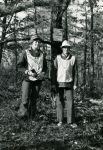
27th: Deer 'season' (read: systematic slaughter) is approaching and we are getting ready to welcome our dedicated volunteers who will help us ensure that the animals will have safe haven from hunters. Because today is 'Throwback Thursday', here is a photo from our archives showing you a couple of our volunteers from 1975. Our walkie-talkies have since been replaced by cell phones, but not much else has changed in 40 years! #uwrhistory #tbt #throwbackthursday – with Diane Barry Harrell and Bruce Barry. – VVH
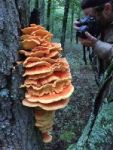
26th: We found this incredible display of a vibrant "sulphur shelf" mushroom (Laetiporus sulphureus) growing on an oak tree alongside an inner trail. Photographed next to Cliff Compton, a frequent contributor to the Refuge's photo archives, you can appreciate the size of this fungus. We saw it from hundreds of feet away as an orange "blaze" in a dense growth of trees. – VVH
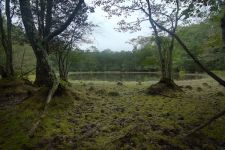
24th: The "Muddy Bog" along one of the trails remains one of my favorite places at the Refuge. Filled with obligate plants indigenous only to the Pine Barrens and covered in a thick bed of peat mosses, it is a remarkable stop along a daily hike. (photo by Cliff Compton) – VVH
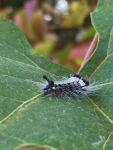
23rd: We see many different types of caterpillars throughout the Refuge. We do not always know the name given them by taxonomists (does it really matter?). Does anyone recognize the species of this beautiful individual? – VVH
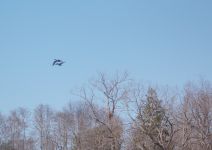
21st: Two Canada geese flying over the main pond at the Refuge. – VVH
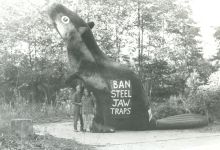
20th: Refuge founders Hope Sawyer Buyukmihci and Cavit Buyukmihci worked diligently more than 30 years ago to help ban leghold traps in New Jersey (see urgent appeal in yesterday's post). In honor of their dedication to this issue, for 'Throwback Thursday' we are sharing a photo from our archives showing them alongside 'Betsy Beaver', an icon for the move to ban the trap. #uwrhistory #tbt #throwbackthursday – VVH
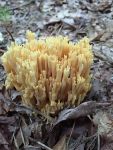
17th: Among the plentiful and photogenic fungi at the Refuge, the coral fungi, such as this one, are among our favorites. – VVH
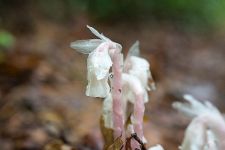
16th: Known colloquially as Indian pipe or ghost plant, we found this gorgeous example of Monotropa uniflora in the understory of the forest on our main trail. Unlike most other plants, M. uniflora does not contain chlorophyll which is required for photosynthesis. It nourishes itself by parasitizing the mycorrhizal fungi which are symbiotic with certain trees. As a result, M. uniflora ultimately uses the photosynthesis of nearby trees to provide its energy. (photo by Cliff Compton) – VVH
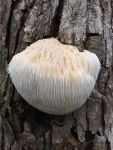
15th: After successive days of rain, we are likely to see many of the diverse fungi at the Refuge making an appearance. This is a nice example of the lion's mane or hedgehog fungus (Hericium erinaceus). Although gaining some attention for its medicinal uses and nerve-regenerative properties, we appreciate it for its intrinsic value and beauty. – VVH
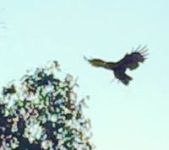
14th: A turkey vulture comes in for a landing. Notice how the primary feathers are fanned out, acting as a "brake" to slow down flight. If you think these versatile feathers are reminiscent of our fingers, you are right. We all inherited the same bones from our common ancestors and adapted them in different ways. Birds, human beings, bats, whales and others all have the same arm bones, including the phalanges -- or finger bones -- we just use them differently. – VVH
|
13th: Recently, we heard a distinctive cry coming from across the main pond for several evenings in a row. Not knowing who was responsible, but thinking it was probably a bird, we took an audio recording and played it for a few local naturalists. Their consensus was that it was likely a young fox or coyote calling for their mother or siblings. Still convinced it was a bird rather than a mammal, we sent the recording to an ornithologist friend. Without hesitation, he identified this plaintive, repetitive cry as a young barred owl calling for food. You may need to turn up the volume to maximum to appreciate this youngster's voice amongst the other sounds of that evening. If you have trouble with our embedded audio on this page, you can access it directly by clicking here. – VVH |
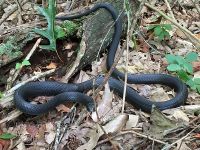
12th: We saw this black snake along the trail where he or she immediately assumed a defensive pose. Black racers and black rat snakes are similar in appearance and it can be difficult to differentiate them without close inspection requiring handling. Black rat snakes tend to be shy and prefer to slip away from threats. We think this individual was a black racer, based on the slightly bolder behavior we saw. – VVH
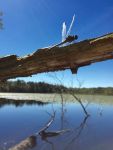
11th: A dragonfly perched upon a branch overlooking the main pond. Kudos to anyone who knows the species. – VVH
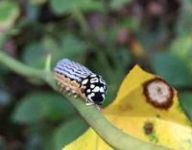
9th: We recently saw this striking caterpillar of the turbulent Phosphila moth (Phosphila turbulenta) on the caterpillar's host plant, the greenbrier. These individuals are spotted at both ends with white spots which some think are false eyes, presumably to discourage predators. The larger false eyes are on the hind end (pictured) with a smaller set on the face. – VVH
|
7th: We see this small beaver swimming peacefully across the main pond almost every night. We were able to capture her or his journey at sunset recently. Here is a direct link to the video in case you have difficulty playing it on this page. – VVH |
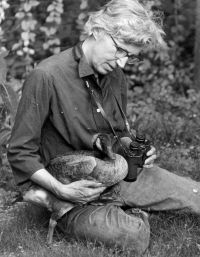
6th: We chose this photo for 'Throwback Thursday' not only to provide a glimpse into the archives of the Refuge, but also to provide another lesson on how to deal with wildlife. Although we do not have the date and exact circumstances, we believe this young Canada goose being cradled by co-founder Hope Sawyer Buyukmihci (my mother) was being rehabbed for release to a free-living state. If my mother was alive today, I think she would agree that it is wrong to become friendly with wildlife during rehabilitation and that we should try to maintain their wariness of human beings. Wildlife who have been acclimated to close association with people have no idea who is safe and who should be avoided. We have seen numerous instances where this lack of fear has resulted in the untimely death of individuals who have approached the wrong people. We must not act on our personal desires to cuddle or otherwise befriend an individual in need; we need to keep them 'wild' so that they can make the right choices when free. – NCB
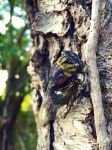
4th: This was a busy summer for cicadas. If you are in the northeastern part of the US, you might have had an audible clue by now. We had a few species of 17-year cicadas emerge as well as these annual cicadas. Contrary to their description, annual cicadas do not have a one-year life cycle; they have two- or three-year cycles. Because cycles overlap, people will see some cicadas every summer. This little one is from the genus Neotibicen, part of the "annual" cicada group. – VVH
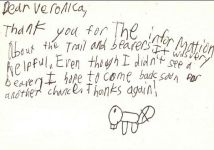
3rd: This "thank you" note was sent to us by an 11-year-old boy who came, binoculars in hand, to observe the diverse wildlife at the Refuge. His favorite animal is the beaver and, although he did not see one this time, his zeal and excitement were not diminished and he plans to visit again with hopes of fulfilling his wish next time.
Notes like this remind us of how important are our jobs as wildlife advocates. This Refuge has always been a safe and protected sanctuary for New Jersey wildlife, but we also have a legacy of education and outreach which is just as vital. People are more likely to protect what or whom they understand. It was a pleasure to meet a youngster who is just as enthusiastic about wildlife as we are. – VVH
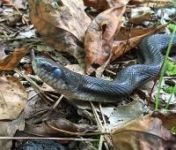
2nd: We saw this small rat snake in the middle of the trail just beginning her or his molting or shedding of skin. Known technically as ecdysis, this happens as a snake grows and produces new skin cells under the old. The old skin then is rubbed away, often as one inside-out piece. The eyes are covered by specially adapted transparent skin called a spectacle. Like the rest of the skin, this turns blue-white and is shed at the same time. The process of shedding makes snakes particularly vulnerable. Because this is a stressful time, we quickly took the photo and walked away. – VVH
30th: A coyote in Newport, RI, began showing up at people's residences. Instead of discouraging him, people began feeding him. This was a serious mistake as anyone who understands and cares about wildlife knows. Coyotes and other wild animals are not likely to distinguish between 'friendly' human beings (if seriously misguided) and those who would kill them. By lessening this individual's innate fear, the people involved sentenced him to death. Although there is some movement to prevent him being shot, the 'option' that is being put forth is to send him to a zoo, which is a fate possibly far worse than death. This coyote's story, still unfolding, should be a stark reminder that it is not being kind to feed wildlife or otherwise befriend them; you are ultimately being more cruel than someone who traps or hunts. Let wildlife remain wild! It is their only hope in this human-dominated world.
You can see one story about this coyote here. – VVH
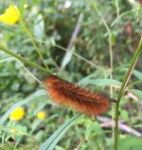
28th: This is the first "woolly bear" we have seen this year, a sure sign of autumn. These bristly caterpillars emerge from their eggs in the fall. They then search for a suitable place to overwinter in caterpillar form. In the spring, they spin a cocoon and emerge as a tiger moth. – VVH
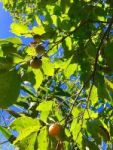
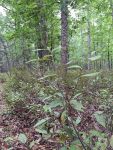
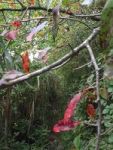
26th: There are signs of fall everywhere. The wild American persimmons are ripening and falling; the northern highbush blueberry is empty of berries; and leaves are beginning to turn color. If you're a bird enthusiast, this is a good time to witness the fall migration as birds start to find resting and refueling spots on their long trips south. – VVH
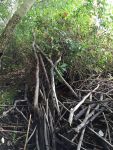
25th: The beavers were busy this week. They added these large sticks to the small dam between the main and Miller ponds. We don't know why they did this, but beavers are incredible engineers and there is always a 'method to their madness'; we are usually too ignorant to know. We're curious to see what unfolds over the ensuing weeks. – VVH
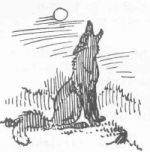
24th: The other night I captured the voice of one of the coyotes howling under a harvest moon. I uploaded the video to YouTube because it seemed to render better than on Facebook. You might have to turn your volume to maximum to hear the calls and they still might not come through well. The moon is just visible as a tiny white spot in the upper part of the video. In time, I hope to get something better; who knows, maybe I will be lucky enough to show the coyote as well as her or his lovely voice! – VVH
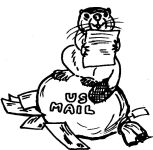
23rd: All people on our electronic mailing list receive our bi-monthly newsletter, Beaver Tales. Those without an E-mail address receive our semi-annual paper version. For those of you who only get the electronic version, you can see paper version in our Archives (menu choice on left) or by clicking here. – NCB
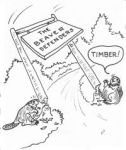
22nd: We are instituting a new feature wherein on most Thursdays, we will post to our Facebook page an image or situation from the Refuge archives to provide a little bit of Refuge history. This week's is a cartoon our co-founder Hope Sawyer Buyukmihci penned depicting what beavers here might think of our efforts. It is undated, but we think it is from the 1960s. – VVH
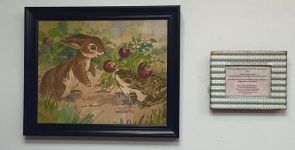
20th: For the months of September and October, Wildflower Vegan, a vegan cafe in Millville, NJ, will be displaying the work of Refuge co-founder, Hope Sawyer Buyukmihci. The prints were made from some of Hope's original artwork created while she was at the Refuge, depicting the local wildlife in a mix of watercolors. No efforts were made to "restore" Hope's original artwork. As a result, the prints show the effects of the paintings having been on display in the cabin for about half a century.
You can purchase prints at the cafe located at 501 North High Street. You can also purchase these prints online through our Zazzle storefront. We hope you will help support the Refuge through this unique opportunity. – VVH
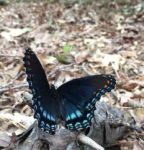
19th: Another striking example of mimicry for survival is seen in the red-spotted purple butterfly shown here. This species has evolved to appear similar to the pipevine swallowtail butterfly who is poisonous to many predators. – VVH
|
18th: An important aspect of adaptation is mimicry, the ability of one species to appear or behave similarly to another in order to gain an advantage for survival. One such adaptation for defensive purposes is seen in the shy and docile rat snake, who will shake their tails vigorously in dried leaves creating a 'rattling' sound, presumably to trick predators into concluding that they are a venomous rattlesnake. Here is a direct link to the video in case you have difficulty playing or viewing it on this page. – VVH |
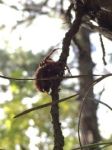
14th: We are seeing a lot more of these stunning cross orbweaver spiders now that summer is fading into autumn. This female's web across one of the trails was about 20 inches across. We had to navigate carefully around the edges in order not to disturb her. The orbweaver is fastidious in her web-building, cleaning each web frequently throughout the day and dismantling it at the end of the evening. – VVH

13th: Adam Zipkin, Council to US Senator Cory Booker (D-NJ), stopped by this week for a tour of the Refuge. Adam worked alongside us to try to help save the beaver family in Toms River, NJ, after the mayor decided to kill the entire family who had been living on a small lake in a residential area. If you will recall, as the story unfolded last November and December (2015), Senator Booker and New Jersey Senator Raymond Lesniak (D) stepped up to add their voices to the growing public opposition to the killings. Although the mayor ordered the beavers killed regardless – and the entire family was slaughtered – we are encouraged to have politicians and their staff who are passionate about saving wildlife. – VVH
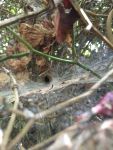
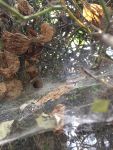
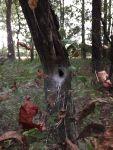
10th: The family of spiders known as "funnel-web spiders" comprises about 700 species. Here is a collection of some examples of pretty funnel webs seen at the Refuge this week. Typically, females will hide in their burrows during the day, but the males will wander from their webs to hunt. We are not sure of the species of the spiders who built these particular webs, though we suspect it is the grass spider. – VVH
9th: We are now registered with the Combined Federal Campaign program. This provides a convenient method for federal employees, postal workers or members of the U.S. military to donate to us. Our CFC Number is 39915. – NCB
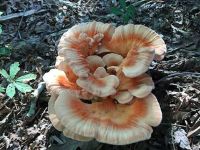
8th: We found this gorgeous, colorful example of the white-pored chicken of the woods fungus Laetiporus cincinnatus, near one of the trails at the Refuge. Like its cousin, L. sulphureus, it is a saprobic fungus that prefers oak trees. – VVH
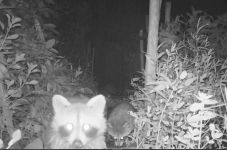
4th: This still image was selected from a video taken by a trail camera by the pond. You can see four young raccoons (two in the foreground, two in the back) just moments before the curious quartet knocked the camera down to the ground. – VVH
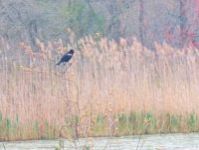
1st: A red-winged blackbird calls out his characteristic song from the wetlands near the main pond on the Refuge. – VVH
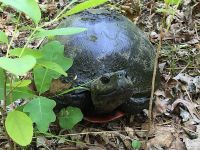
29th: We met this bold, curious northern red-bellied turtle (Pseudemys rubriventris), an endangered species, this weekend in Squirrel Haven, which is the beginning to all our main trail heads. – VVH
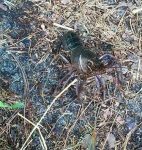
25th: We know that crayfish sometimes walk some distance on land, surviving being away from water for days if the conditions are humid enough. We were, nevertheless, still surprised when we spotted this little one trundling across a path hundreds of feet from the main pond. – VVH
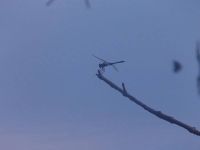
21st: One night while patiently and quietly waiting for one of the local beavers to make her nightly trek across the boardwalks from the main to the Miller pond, we caught this striking image of a dragonfly silhouetted against the sky at dusk. – VVH
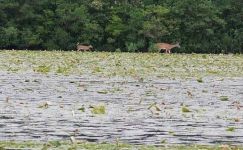
17th: Each evening since the fawn was able to delicately pick her or his way behind mom, this mother and baby have been at the edge of the main pond, dining on water lily and drinking from the water's edge. They are a clockwork reminder why Unexpected Wildlife Refuge was founded and why our annual volunteer patrols are so important. – VVH
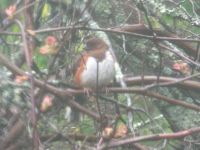
15th: We hear these sparrows often, but see them infrequently. They spend much of their time in tangled underbrush making them difficult to spot. I was able to follow this female eastern towhee's lovely voice and use our zoom lens to get this admittedly less than ideal photo. The males and females of this species are patterned similarly. The females, however, are rufus-brown whereas the males are smoky black. – VVH
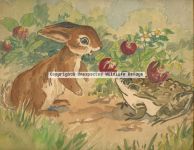
14th: If you are in Millville, New Jersey, this September...
A selection of co-founder Hope Sawyer Buyukmihci's watercolor paintings of wildlife at the Refuge will be on display for the entire month of September on the walls of Wildflower Vegan, a vegan cafe in Millville, NJ. The displayed prints will be available for sale on site. All money raised will go to support the Refuge. Wildflower is located at 501 North High Street; telephone 856.265.7955. – VVH
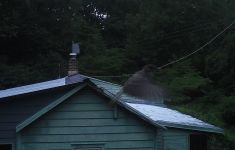
10th: We developed a faster motion-triggered shutter for one of our trail cameras with the aim of getting high-quality images of the bats who live here. To test this feature, we placed the camera on the roof of our barn. No bats so far, but we did get a lovely photo of this little guy. Keep coming back as we will post more images as they are captured... – VVH
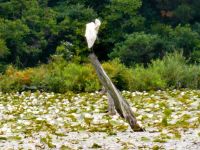
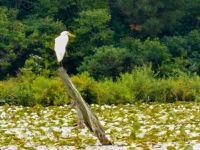
13th: Monday morning I was enchanted to find a great egret had suddenly appeared at the Main pond. He or she circled slowly and then disappeared. I thought I heard someone in the trees the next day, but still no second appearance.
This morning, the elusive bird was back, perched low over the water, preening. If you look closely, you can see the hint of the long, wispy feathers that are the great egret's breeding plumage. And indeed, just moments later, a second egret appeared and the pair took off into the tree line. – VVH
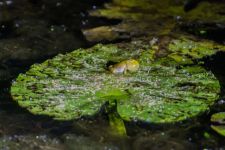
5th: This tiniest frog, the northern cricket frog, was proclaiming in a disproportionately LOUD call from a lily pad in the Main pond at the Refuge. Endangered and a species of concern in three states, these frogs are small enough to fit on a silver dollar with room to spare. Sensitive to environmental pressures, they are harbingers of good water quality. We took this photo in total darkness with a flashlight and a 600mm lens from shore and were very happy when the little one "decided" to inflate and vocalize for the camera. Photo by Cliff Compton. – VVH
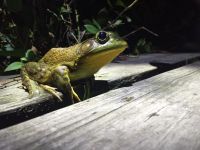
3rd: In the nightly chorus of frogs and toads, the bullfrog is our basso profundo. The bullfrog and the green frog have very different songs, but are frequently visually confused for each other. The easiest way to distinguish them is to look at the glandular fold, the ridge running right by the eye down to the frog's tympanum ('ear drum'). In the bullfrogs, like this one crossing one of our boardwalks, it is curved around the ear drum. On the green frogs, this ridge goes straight on down the back. – VVH
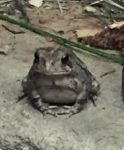
21st: This little guy found his way to one of our sheds to wait out a storm. – VVH
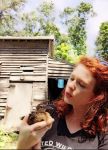
20th: A neighbor dropped this little guy off just now and we have a local rehabilitator visiting this morning, so we are holding him for her. We think he might be a young king rail, hit by a car in Hammonton (New Jersey). Please remember that the Refuge is a protected sanctuary for all indigenous wildlife, but we are not licensed or equipped to take in injured animals for rehabilitation. We do, of course, always try to help when we can, but please always consult your statewide list of approved and licensed rehabilitators when you find injured wildlife. And thank you, always, to everyone who cares enough to stop and help an injured someone when it is safe to do so. Keep the injured individual gently restrained in a darkened container (to reduce stress) and free from noise and human commotion until a professional can help. Go to our Home page for a link to rehabilitators in New Jersey. – VVH
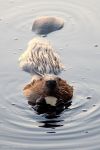
17th: Some might recall that a few weeks ago, a housing authority close to Mullica Hill, NJ, called us asking for our help building drainage for a modest beaver dam in the woods behind (and downhill) of some residences. Homeowners had complained about the local beavers who had just moved in -- even though the beavers were causing no trouble and were at least a half a mile from the closest backyard. Naturally, we offered to step in before someone decided to trap and kill the beavers.
The president of the Homeowner's Association was incredibly cooperative. He emailed us just this afternoon to report that the beaver family had moved on of their own accord.
There is an important lesson here: beavers move. Sometimes they run out of food, or don't find as much as desired or needed. Some young beavers and others are "transient", settling down briefly before finding a 'permanent' home. The take-home message is this: Animals other than human beings belong here as much as we do. They need the same things that we need: a home, food and security for their families. And, most of the time, if we stop interfering, relax and wait, they work things out just fine on their own. – VVH
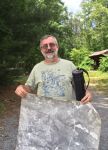
16th: We had a guest at Unexpected this week who helped us explore and discuss reasons behind the Refuge's remarkable biodiversity and geodiversity. Geographer Mark Demitroff studied and wrote about the local Ice Age (Pleistocene) era, the geological features of the Refuge and the surrounding Pine Barrens.
According to Mark, "Unexpected's topography is remarkably complex. Its wonderful biodiversity can be attributed to the site's high geodiversity. Unexpected is also a location of scientific significance. Numerous papers were published on Unexpected's ancient cold non glacial (periglacial) features ... hundreds of geology buffs from around the world visited here on various excursions."
Mark's opinion is that our beavers might even have Pleistocene roots, going back to a time when the landscape was cold, dry, and windy. The photo shown is of Mark, holding a circa 1931 aerial map of our Marsh Lake Branch, during his visit to the Refuge to discuss our old, frozen dirt, ground that holds valuable terrestrial clues to abrupt past climate change. – VVH
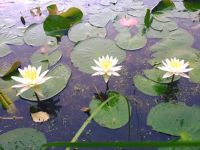
8th: The white water lilies have become quite a popular early-morning delicacy among the deer on Unexpected. We find the deer, after dawn, in water chest-high, wading halfway across the pond to nibble on the leaves. In the evening, the resident beavers swim out and enjoy their share. – VVH
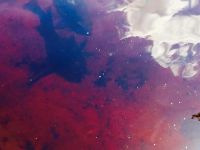
6th: A male pumpkinseed watching his carefully excavated nest -- part of the sunfish family, often colloquially referred to as a group as "sunnies", male pumpkinseeds (and bluegills with whom they sometimes breed) dig their nests in the spring. Digging with their caudal fins in sand in the warmer waters near shore, they will carefully pick up rocks and debris and clean the nest before the females arrive.
It is the males who watch the nest. And when the young hatch, they will protect them for about two weeks -- even picking up their offspring to return them to the safety of the nest when the young stray too far. – VVH
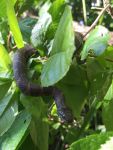
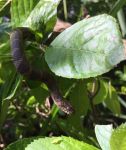
1st: Saw this juvenile northern water snake basking in the sun, small body wrapped comfortably around a branch by the main pond. Though all snakes can bite if sufficiently threatened (the result being minor scraping of the skin), out of the 22 species of snake native to New Jersey, only two are venomous. It is easy to identify the latter because you only have to choose from copperheads (distinctive coloring) or rattlesnakes (obvious rattle). Also, these individuals have vertical pupils and 'pits' (heat sensors) between the eyes and nostrils, not that we recommend your getting that close to verify. Although the chance of running into a venomous snake in New Jersey is highly unlikely, if you are unsure, then just leave the individual alone. In fact, you should leave any alone so as to respect their privacy! – VVH
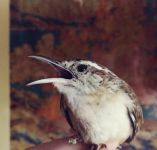
28th: This tiny Carolina wren "invited" herself into the house this morning. If you find yourself with an avian visitor, stay calm and quiet; some birds are very delicate and sensitive. Move any companion animals away. It is important that there be a clear path to the outside, whether it be through open windows or a door, with no possibility of deviation into other rooms. You need to move slowly and give the bird a chance to fly out; they usually can and do. You may need to leave the room to prevent the bird becoming panicked and becoming injured by collision with the walls or window frame. If the bird becomes dazed due to trauma, place them in a secure carrier in a dark, quiet room until they recover, and then release them outside. If that fails, call a wildlife rehabilitation expert for advice.
This little one did not seem to be able to escape, so I very quietly came up behind with a towel, gently covered her and brought her outside. Success! – VVH
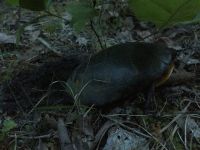
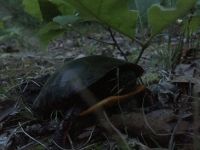
27th: It was full twilight when I almost missed this charming little eastern painted turtle, Chrysemys picta picta (two names after the capitalized genus name means this is a subspecies of the painted turtles). When I bent down to photograph her, I discovered she was digging the nest where she will lay her eggs. What a moment. I walked very quietly away to prevent disturbing her at her evening's work. – VVH
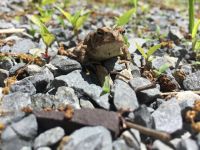
26th: A small toad with a big call, this Fowler's toad (Anaxyrus fowleri) was spotted sunning himself on some sun-warmed stones. Previously considered part of the widely-encompassing Bufo (Latin for "toad") genus, the Fowler's toad has now been firmly placed into genus Anaxyrus with about 20 other toad species. They like to breed in vernal pools and in the shallower edges of lakes and ponds. They are endangered in Canada and sensitive to habitat interference in the United States. Reptiles_and_Wildlife LINY have posted a short video of one of these toads. – VVH
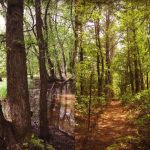
25th: Good news! Though part of our boundary trail has been under water since the snowmelt in early spring, it is almost dry. If you've been planning to come back to walk the beautiful boundary trail, it's pleasantly walkable and full of green trees, mosses and flowers and the adjacent swamp is full of life. – VVH
| 12th: Sunset at Unexpected. The male bullfrogs have been actively advertising themselves to each other and any female bullfrogs within earshot. The deep, reverberating calls are quite loud ... an American bullfrog's call can be heard up to a mile away. Here is a direct link to the video in case you have difficulty playing it on this page. – VVH |
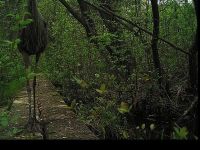
10th: Someone decided to spend a good portion of their morning standing right in front of one of the trail cameras. The video the camera captured shows this great blue heron standing so motionless that only the mild ruffling of some feathers in the breeze belied it was not a still photo. – VVH
9th: Our Director has set up a GoFundMe account as a means of developing and funding specific campaigns to help the Refuge. Our initial campaign in this regard is Protect Wetlands from ATV Use. We hope you will support us in this and future campaigns. You can access the GoFundMe information through our Help Us page or visit our GoFundMe site for more information. – NCB
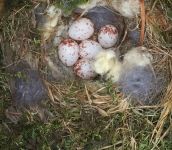
2nd: I quickly took this photo -- using my iPhone, a stick and a remote shutter -- of a beautiful clutch of Carolina chickadee eggs when the parents were away. Notice the characteristic mossy cup-like nest. Both parents help excavate a nesting site, once the female approves a spot. The female then builds a nest out of moss and soft and coarse plant materials, and lines it with downy animal fur (frequently from rabbits, like the gray fur here). Although I love the opportunity to witness and share this, I likely will not take many or any more this season because we would not take even a hasty photo unless we were certain that nobody would be disturbed by the action. :) – VVH
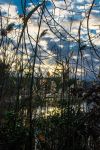
1st: An atmospheric shot this weekend of the main pond, through the reeds and wild wetland plants by Cliff Compton, one of the photographers who frequent the Refuge. – VVH
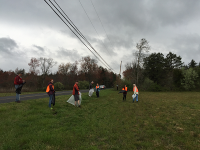
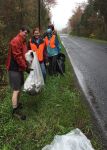
24th: A dozen dedicated volunteers joined us yesterday to clean trash from the miles of Piney Hollow Road adjacent to the Refuge. After a couple of hours of work in the rain, we were able to gather back on the Refuge for vegan kebabs made with Szechuan and Mandarin Gardein, vegan potato salad made with Just Mayo and cookies baked by one of our awesome volunteers. – VVH
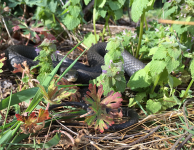
23rd: A small black rat snake alongside one of the trails. – VVH
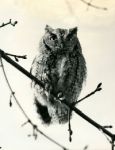
20th: UWR has been protecting Pinelands habitat and wildlife for more than 55 years. The Refuge has grown to almost 800 acres since 1961, providing a home for the diverse indigenous species of the Pine Barrens region, including those threatened and endangered by habitat loss and fragmentation. Thank you to our supporters and donors; without you, the Refuge would not exist. We now have a new way to help Unexpected using JustGiving.org. You can help support the Refuge with a quick click on the new "Donate Now" button on our Facebook page or through our Help Us page where you will find links to our JustGiving.org page and more. – VVH
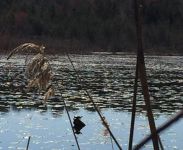
18th: Just caught this little one enjoying a good bask in the sunshine. – VVH
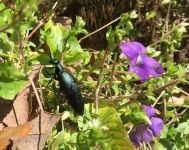
15th: An iridescent buttercup oil beetle (Meloe americanus) taste-testing some of the leaves by the trails. Fans of buttercup, when available, the oil beetles are leaf-eaters when adults. Their life-cycle, though, is more complex. As young, the oil beetles attach themselves to flowers and use pheromones to signal to passing male bees. The male bees pick up the small hitchhikers and pass them onto the females who then carry the young home. The beetles eat pollen and grow up in the bees' nest and emerge as adults. In England, the oil beetle is in danger -- a direct result of the collapse of bee populations. – VVH
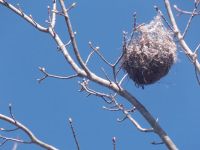
13th: Orioles frequently recycle nest materials from the previous year's nest -- they also love to incorporate milkweed, if they can find it. The nests are built as small hanging baskets suspended from branches. This one is on one of the small islands of vegetation in the middle of one of the ponds. – VVH
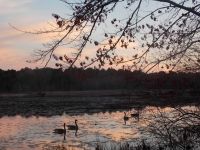
12th: Sunset on the main pond. – VVH
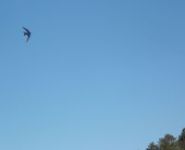
11th: Tree swallows are among some of the first short-distance migrators to arrive in the spring. Dozens of them swoop and dive low over the main pond, catching insects on the wing. Note the compact, aerodynamic shape compared to the great blue heron we photographed yesterday. – VVH
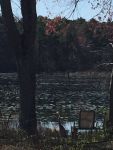
10th: One of the great blue herons has taken over the best observation spot on the pond. – VVH
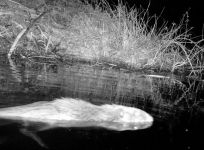
5th: One of the trail cameras set on the water caught this pretty cool aquatic shot. The water doesn't reflect the infrared flash the same way it reflects sunlight so you can see for a few inches below the waterline. It's enlightening to watch any animal in their environment -- and get to see physical attributes which have evolved over millennia to give them perfect adaptations to succeed in their ecological niche such as this beaver's large, webbed back feet used to paddle efficiently around in the water. – VVH
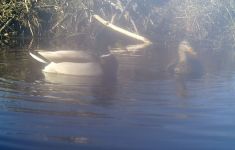
31st: The theme on the Refuge this week continues to be couples. This mallard couple were caught early this morning, in the bright sunshine, by one of the trail cameras on the water near the main beaver lodge. Spring is most definitely in swing. – VVH
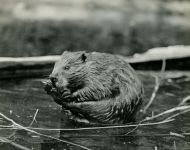
23rd: We have just received the information on the beavers killed at Lake Placid, Toms River, New Jersey. You may remember that, despite our and others' willingness to help the municipality with proven, non-lethal methods to resolve the 'problem' (only in the eyes of a few people), Mayor Thomas F. Kelaher ordered the execution of the beavers. So far, twelve beavers have lost their lives as a result of misinformation, arrogance and intransigence. You can see the execution order approved by the Mayor as well as the death toll report.
You may want to contact the Mayor and let him know that his actions have not gone unnoticed, that we all mourn the loss of these innocent victims and that he needs to start viewing the world compassionately as something shared with others, not owned by people.
Mayor Thomas F. Kelaher– NCB
E-mail: TKelaher@tomsrivertownship.com
Mailing address: Post Office Box 728, Toms River, New Jersey 08754-0728
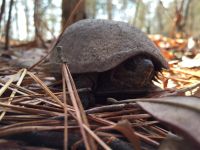
16th: A sandy little Eastern mud turtle (Kinosternon subrubrum) was marching alongside the trail. Endangered in two states, the Eastern mud turtle is recognizable by the unusual pattern of 11 marginal scutes, or plates, making up their shells, instead of the more common 12. – VVH
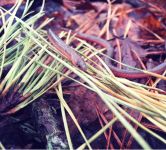
15th: Came across this small Eastern worm snake (Carphophis amoenus amoenus) just now. It was a bit of a happy surprise. These guys are burrowers and rarely seen above ground. These snakes are a subspecies (you can recognize a subspecies when you find not one but two Latin names after the capitalized genus name) in the huge, encompassing family Colubridae. Really cool to see this little one making her or his way across the leaf litter in the light rain. – VVH
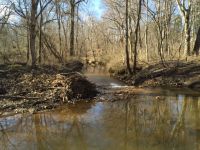
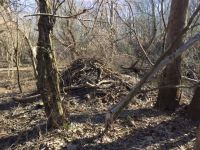
10th: There is nothing that makes us more optimistic than people reaching out to us to start a conversation about humane ways to become better neighbors to beavers (and all wildlife). I took a call on Monday from the president of a homeowners' association for a large housing development in Mullica Hill, New Jersey. He was concerned about complaints by residents about a family of beavers in the woods behind the development. The state of New Jersey told the residents to lethally trap the animals! That was their first and only solution. But they didn't accept that and called us. I visited with them yesterday. The residents have taken down half the dam. They didn't understand that exposing the lodge, to these beavers, would be like us trying to sleep in a house after someone removed all of our exterior doors. It's a terrifying security issue. We have recommended and will help them install, instead, a flexible pond leveler. With pond levelers, YOU choose the height of the water that is acceptable, install it in a free-standing dam and everyone is happy. – VVH
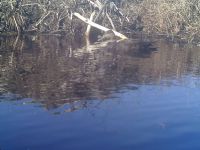
8th: Earth Day Clean-Up is happening April 23! We need a few awesome volunteers this year to meet us on Piney Hollow Road in Newfield, to clean up trash along the road where it borders Refuge land. We will be out there from 11 am until 1 pm. Free (vegan) lunch back on the Refuge by the lake at 1 pm! Please email me at director@unexpectedwildliferefuge.org to sign up to be part of the team that keeps this safe haven pristine. – VVH
| 2nd: Our Director managed to capture the wonderful sounds of frogs 'waking up' from their winter slumber. You can see a video of the pond with the cacophony of chorus and wood frogs in the background. Here is a direct link to the video. – NCB |
29th: We set out a trail camera on the water by our largest beaver lodge hoping to see their warm-weather stirrings. Today, though, we also found these stunning images of a Great blue heron's landing on top of the lodge -- as reflected by the water... And, then along came a wood duck to become part of the image! – VVH
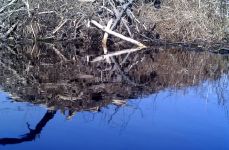
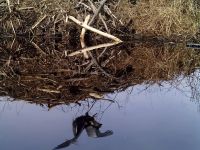
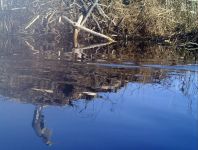
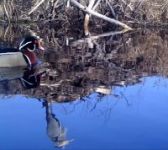
|
28th: Kevin Riordan of The Inquirer and staff photographer Tom Gralish recently spent time getting to know the Refuge and produced a great, informative story. If the story is no longer at that address, you can see a PDF version.– NCB
|
24th: Spring is beginning to assert itself on the Refuge – VVH |
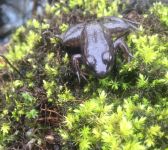
|
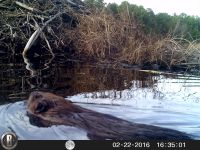
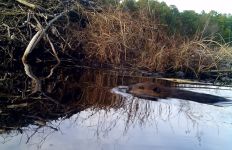
22nd: Our Director had placed one of our trail cameras near one of the beaver lodges some time ago. She again braved the ice-cold pond to see what, if anything, was on the camera. To all our delights, there were these wonderful photos of a beaver swimming to the lodge. – NCB
18th: We have a new leaflet on beavers, Living with beavers. It was put together by our Director and is available online. – NCB
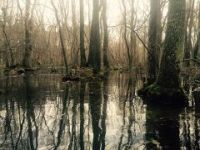
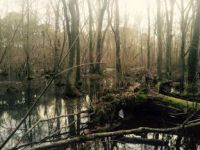
17th: The Pine Barrens are home to a variety of wetland ecosystems. Bogs, fens and Atlantic white cedar swamps are among the most valuable habitats to native plants and animals. The Refuge is home to them all, making a place for many of New Jersey's indigenous birds, amphibians, reptiles, invertebrates, mammals and plants. – VVH
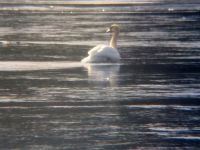
12th: We have a new guest at the Refuge. She's been here three days peacefully paddling around the Canada geese. – VVH
9th: The Refuge is filled with couples this week. We saw quite the courtship dance yesterday of a turkey wooing his hens and today the lake is filled with geese and ducks. It will be baby season soon. – VVH
[Editor's note: Veronica was able to make an audio recording of the turkey, who was too deep in the woods for a good video. You can listen below. – NCB]
|
Listen to tom turkey courting his hens:
|
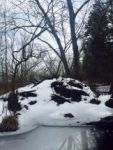
1st: The lodges are still snow-capped on this 50-degree day. Beavers can spend an entire winter in the lodge, surviving on aspen, alder and willow tree branches that they sink into the mud, like a storage cellar, by the lodge entrances. They spend all of the fall season cutting and storing food for the winter. The temperature in the lodge stays consistently above freezing all season and oxygen concentrations stay balanced with engineered ventilation shafts. – VVH
26th: Foxes have very sensitive ears. They can hear a mouse squeak under a foot of snow or 300 yards away. They can hear a watch ticking more than 30 yards away. Though we have painted the LEDs on our cameras black and the shutter sound is minute, this fox heard it. Walking along one of the paths, she stops and looks directly at the invisible camera, pinpointing its location precisely, just by the tiny "click" of the shutter. – VVH
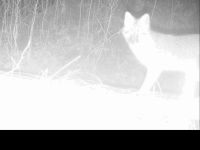
|
24th: The one less traveled by. – VVH
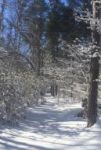
|
20th: Distinguishing between the Cooper's hawk and the slightly more diminutive Sharp-shinned hawk can be challenging. With both feet and neck tucked against the cold, the only thing that helped to identify this Cooper's hawk by the cabin today, was sheer size and the shape of a slightly blockier cranium. – VVH
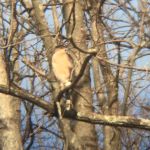
|
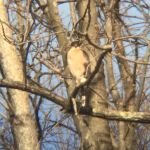
|
18th: I wonder if Hope and Cavit had any idea how much traffic these walkways would see. Turkeys, raccoons, rabbits and yes ... Those doglike prints below are from one of our elusive canid residents. I do frequently see the rabbits alongside the turkeys and the grouse, traveling together across the trail camera's lens. – VVH
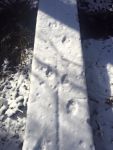
|
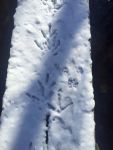
|
| 5th: Speaking of ice. Winter is actually coming now, to the northeast. On days when you are second-guessing leaving the house, download some of our free downloadable wildlife coloring pages to keep everyone happily occupied ... they're a great way to discuss and learn.– VVH |
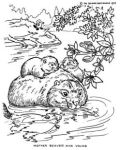
|
4th: Our trail cameras captured these beautiful images of a Carolina duck pair in the wetlands deep in the woods. Carolina ducks, or wood ducks, love the habitat created by beavers and you frequently see the two sharing the same spots. Once in a very serious decline, the wood duck's numbers have rebounded thanks to protections for migratory birds, including preserving and recreating vital habitat. – VVH
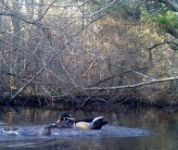
|
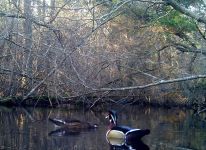
|
RSS services:
Feed Shark
R-bloggers.com
RSS-Dir.com
RSS Feed Directory - Search and read RSS Feeds without any RSS reader